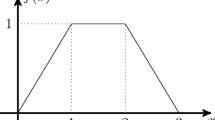Abstract
Two-stage stochastic mixed-integer programming (SMIP) problems with recourse are generally difficult to solve. This paper presents a first computational study of a disjunctive cutting plane method for stochastic mixed 0-1 programs that uses lift-and-project cuts based on the extensive form of the two-stage SMIP problem. An extension of the method based on where the data uncertainty appears in the problem is made, and it is shown how a valid inequality derived for one scenario can be made valid for other scenarios, potentially reducing solution time. Computational results amply demonstrate the effectiveness of disjunctive cuts in solving several large-scale problem instances from the literature. The results are compared to the computational results of disjunctive cuts based on the subproblem space of the formulation and it is shown that the two methods are equivalently effective on the test instances.
Similar content being viewed by others
References
Ahmed S. and Garcia R. (2003). Dynamic capacity acquisition and assignment under uncertainty. Ann. Oper. Res. 124: 267–283
Alonso-Ayuso A., Escudero L.F., Garín A., Ortuńo M.T. and Perez G. (2003). An approach for strategic supply chain planning under uncertainty based on stochastic 0-1 programming. J. Global Optim. 26: 97–124
Balas, E.: Disjunctive programming: cutting planes from logical conditions. In Mangasarian, O.L., Meyer, R.R., Robinson, S.M. (eds.), Nonlinear Programming 2. Academic Press (1975)
Balas E. (1979). Disjunctive programming. Ann. Discrete Math. 5: 3–51
Balas E. (1984). Disjunctive programming and a hierarchy of relaxations for discrete optimization problems. SIAM J. Algorithmic Discrete Math. 6: 466–486
Balas E., Ceria E.S. and Cornuéjols G. (1993). A lift-and-project cutting plane algorithm for mixed 0-1 integer programs. Math. Programming 58: 295–324
Balas E., Ceria E.S. and Cornuéjols G. (1996). Mixed 0-1 programming by lift-and-project in a branch-and-cut framework. Manage. Sci. 42: 1229–1246
Blair C. and Jeroslow R. (1978). A converse for disjunctive constraints. J. Optim. Theor. Appl. 25: 195–206
Carøe, C.C.: Decomposition in stochastic integer programming. Ph.D. thesis, Dept. of Operations Research, University of Copenhagen, Denmark (1998)
Carøe C.C. and Tind J. (1997). A cutting-plane approach to mixed 0-1 stochastic integer programs. Euro. J. Oper. Res. 101: 306–316
Inc. ILOG.: CPLEX 9.0 Reference Manual. ILOG CPLEX Division (2003)
Laporte G. and Louveaux F.V. (1993). The integer L-shaped method for stochastic integer programs with complete recourse. Oper. Res. Lett. 1: 133–142
Laporte G., Louveaux F.V. and Van Hamme L. (2002). An integer l-shaped algorithm for the capacitated vehicle routing problem with stochastic demands. Oper. Res. 50: 415–423
Ntaimo, L.: Disjunctive decomposition for two-stage stochastic mixed-binary programs with random recourse. Submitted (2006), http://ie.tamu.edu/people/faculty/Ntaimo/default.htm
Ntaimo L. and Sen S. (2004). The million-variable ‘march’ for stochastic combinatorial optimization. J. Glob. Optim. 32(3): 385–400
Ntaimo, L., Sen, S.: A comparative study of decomposition algorithms for stochastic combinatorial optimization. Comput. Optim. Appl. J. (2006) (To appear)
Sen S. and Higle J.L. (2005). The C3 theorem and a D2 algorithm for large scale stochastic mixed-integer programming: setconvexification. Math. Program. 104(1): 1–20
Sen S. and Sherali H.D. (1987). Nondifferentiable reverse convex programs and facetial cuts via a disjunctive characterization. Math. Program. 37: 169–183
Sen S. and Sherali H.D. (2006). Decomposition with branch-and-cut approaches for two stage stochastic mixed-integer programming. Math. Program. 106(2): 203–223
Sherali H.D. and Shetty C.M. (1980). Optimization with disjunctive constraints. Lect. Notes Econ. Math. Syst. 181: 411–430
Van Slyke R. and Wets R.-B. (1969). L-shaped linear programs with application to optimal control and stochastic programming. SIAM J. Appl. Math. 17: 638–663
Wets R.J-B. (1974). Stochastic programs with fixed recourse: the equivalent deterministic problem. SIAM Rev. 16: 309–339
Author information
Authors and Affiliations
Corresponding author
Rights and permissions
About this article
Cite this article
Ntaimo, L., Tanner, M.W. Computations with disjunctive cuts for two-stage stochastic mixed 0-1 integer programs. J Glob Optim 41, 365–384 (2008). https://doi.org/10.1007/s10898-007-9245-y
Received:
Accepted:
Published:
Issue Date:
DOI: https://doi.org/10.1007/s10898-007-9245-y




